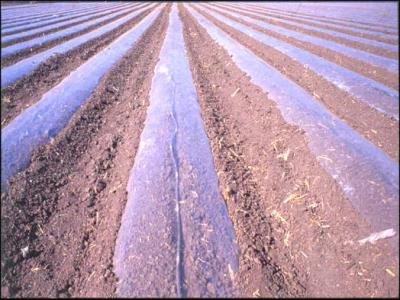Solarisation can be used against the following pests (clicking on underlined pests takes you to pests' page): Cowpea seed beetles, Late blight, leafminers, damping-off diseases, Storage pests of seeds and grains (Grain borers, Grain weevils, Grain moths)
General Information on Soil Solarisation
Soil solarisation is a method of controlling soil-borne pests (soil-borne fungi, bacteria and nematodes) without application of pesticides by placing plastic sheets on moist soil during periods of high ambient temperature. The plastic sheets allow the sun's radiant energy to be trapped in the soil, heating the upper levels. Transparent plastic allows a more effective heating of the soil than black or coloured one. Also, the thinner the plastic the greater the heating will be, though the plastic should be resistant to wind and or puncture by animals should be avoided.
Soil solarisation is most applicable and viable in arid and semi-arid conditions where hot temperatures prevail during day time. However, poor-resourced smallholders may not have financial resources to invest in buying plastic mulches nor leaving their restricted land units for a month without cropping.
Solarisation during hot months can increase soil temperature to levels that kill many disease-causing organisms (pathogens), nematodes, and weed seed and seedlings. It leaves no toxic residues and can be easily used on a small or large scale. Soil solarisation also improves soil structure and increases the availability of nitrogen (N) and other essential plant nutrients. (Elmore et.al., 1997) .
How to prepare the soil:
Soil to be solarised must be well prepared by tilling and should be crumbled to a depth of 30 to 40 cm. Solarisation is effective only if done in moist soil. The field must therefore be irrigated until a depth of 50 to 60 cm before mulching. Solarisation is most effective if the plastic is laid as close to the soil surface as possible. Remove weeds, stones and other debris that could puncture the plastic.
Laying the plastic sheet:
Sheets can be laid by hand. The edges of the sheet should be buried in small trenches around the field. Plastic can be laid either in complete coverage where the entire field to be planted is covered or strip coverage where only beds or parts of the field are treated.
Strip coverage effectively kills most pests and eliminates the need for deep cultivation after solarisation. It is especially effective against weeds, since the furrows are cultivated. Strips should be a minimum of 75 cm wide; beds up to 1.5 m wide. Strip coverage can be more economical because less plastic is needed. With strip coverage, however, longterm control of soil pathogens and nematodes may be lost because pests in the untreated soil in the rows between the strips can contaminate and reinfest treated areas.

(c) Monografias.com
Duration of treatment:
The plastic sheets should be left on the soil for 4-6 weeks to allow the soil to heat up to the highest temperature possible. Then, the plastic can be removed. If the soil must be cultivated for planting, the cultivation must be shallow, less than 5 cm, to avoid moving untreated soil to the surface.
Solarisation of Seeds and Grains
Dry grain and seed that has been attacked by grain weevils, borers or moths can be treated as follows:
1. Put affected grain in a black plastic bag and close tightly, closing in at least 50% air space
2. Put the bag in the sun. If the seeds are to be used for planting, insert a thermometer to be sure temperature inside the bag does not exceed 50°C (above this temperature the seeds will quickly loose capacity to germinate)
3. Leave for a day
4. Check at the end of the day if any insects are still alive. If the sun has been hot enough the insects will have died at the end of the day. If a few are still alive, repeat the treatment. The grain can then be stored using good storage practices as described under storage pests
For further information on storage pests click here.
Information Source Links
- Elmore, C.L., Stapelton, J.J., Bell, C.E. and Devay, J.E. (1997). Soil Solarization - A Nonpesticidal Method for Controlling Diseases, Nematodes, and Weeds. University of California, Vegetable Research and Information Center.
- Soil Solarization Home www.agri.huji.ac.il
